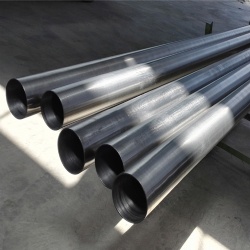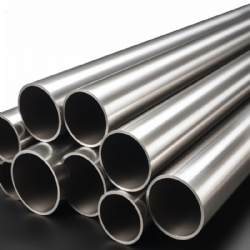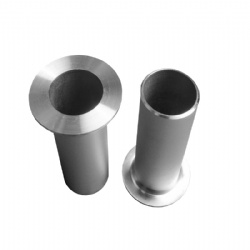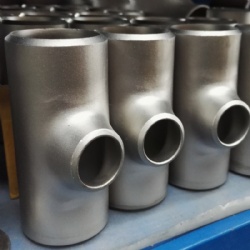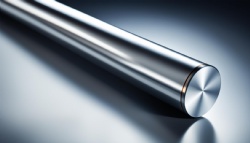Products >> Titanium >>
ASTM B363 titanium fittings
- Product No.:202431610849
Introduction
Welcome to the world of ASTM B363 titanium fittings, a star player in various industries, known for their exceptional qualities. These little heroes might seem like just another component in the vast machinery of construction and engineering, but they hold the secret to longevity, reliability, and efficiency. Crafted meticulously following the ASTM B363 standard, these fittings are more than just a piece of metal. They are the backbone of numerous systems, ensuring they run smoothly without giving in to the harsh environmental challenges. Whether you are delving into their use for the first time or looking to understand their magic a bit more, this guide will shed light on why ASTM B363 titanium fittings are a go-to choice for those in the know.
Benefits of ASTM B363 Titanium Fittings
Corrosion Resistance
One of the standout benefits of ASTM B363 titanium fittings is their exceptional corrosion resistance. These fittings are virtually immune to damage from harsh chemical environments, including seawater, chlorine, and certain acids. This resistance comes from titanium's ability to form a stable, protective oxide layer when exposed to air or water, effectively shielding the metal underneath from further corrosion. This characteristic makes ASTM B363 fittings an ideal choice for applications where they are exposed to corrosive substances regularly, significantly extending their service life and reducing maintenance requirements.
Durability
Durability is another hallmark of ASTM B363 titanium fittings. Titanium is renowned for its strength-to-density ratio, being both strong and incredibly durable while also being lighter than many metals. This means that ASTM B363 fittings can withstand high pressures and extreme conditions without succumbing to wear and tear as quickly as fittings made from other materials might. This durability ensures reliability in critical systems, where failure could have significant consequences, and reduces the need for frequent replacements, thereby saving on costs and downtime over the long run.
Lightweight Nature
The lightweight nature of titanium makes ASTM B363 fittings particularly advantageous in applications where weight is a critical factor. Despite their strength, these fittings are remarkably lighter than their counterparts made from stainless steel or other metals. This weight reduction can lead to significant efficiency improvements, especially in industries where the weight of components plays a vital role in overall performance, such as in aerospace or automotive applications. The lighter weight helps in achieving fuel efficiency, easier handling, and the potential for more compact system designs.
Applications of ASTM B363 Titanium Fittings
Aerospace Industry
In the aerospace industry, the benefits of ASTM B363 titanium fittings directly translate into improved performance and efficiency. Their lightweight yet strong nature allows for the construction of aircraft and spacecraft that are both durable and fuel-efficient. Moreover, their resistance to corrosion and high temperatures makes them perfect for the harsh conditions encountered in aerospace environments. From structural components to hydraulic systems, titanium fittings are used extensively in airplanes, satellites, and space shuttles.
Medical Industry
The medical industry values ASTM B363 titanium fittings for their biocompatibility and the ability to hold up under the demanding conditions of medical environments. Titanium does not react with bodily fluids, which makes it an excellent choice for surgical instruments, implants, and equipment. Its durability and lightweight also contribute to more comfortable and durable prosthetics. These qualities ensure that titanium fittings are a vital part of medical technology, improving patient outcomes and the functionality of medical devices.
Marine Industry
The marine industry benefits from the use of ASTM B363 titanium fittings because of their superior corrosion resistance, especially against saltwater. This resistance extends the life of marine equipment and vessels by preventing the corrosive effects of the marine environment. Applications include piping systems, heat exchangers, and underwater components, where durability and maintenance reduction are crucial. Titanium's strength and lightness also contribute to more efficient and high-performing marine designs, proving indispensable in contemporary marine engineering projects.
Comparison with Other Materials
Picking ug the right material for piping systems is crucial for ensuring longevity, durability, and cost-effectiveness. ASTM B363 titanium fittings stand out when compared to more common alternatives like stainless steel and aluminum. Let's take a closer look at how they stack up.
Stainless Steel
Stainless steel has been the go-to choice for many applications due to its strength and resistance to corrosion. However, when put side-by-side with titanium fittings, a few drawbacks become apparent. For one, stainless steel is heavier, which could add unnecessary weight to structures or systems, making them less efficient or requiring additional support. Additionally, while stainless steel is resistant to corrosion, it can still succumb to rust in extreme conditions or when exposed to certain chemicals. Titanium, on the other hand, boasts superior corrosion resistance in a wider range of environments and maintains its integrity even in the harshest conditions, making ASTM B363 titanium fittings a wiser choice for demanding applications.
Aluminum
Aluminum is known for being lightweight and resistant to corrosion, qualities it shares with titanium. However, when it comes to strength and durability, aluminum falls short. It's more prone to wear and tear, denting, and deformation over time, especially under high stress or in extreme conditions. Titanium fittings, while also lightweight, are significantly stronger and can withstand greater pressure and temperature extremes. This is why, despite aluminum's initial appeal for lightweight applications, ASTM B363 titanium fittings are often preferred for their unrivaled balance of lightness and lasting durability.
Manufacturing Process of ASTM B363 Titanium Fittings
The production of ASTM B363 titanium fittings involves several intricate steps to ensure their high quality and performance. The two primary methods are casting and machining, each with its own set of benefits.
Casting
Casting is a process where molten titanium is poured into a mold shaped like the desired fitting. Once the titanium cools and solidifies, it's removed from the mold, revealing a near-net shape of the fitting. This method is advantageous for producing complex shapes with minimal waste. However, cast titanium fittings often require further processing to refine their dimensions and eliminate any surface imperfections.
Machining
Machining, on the other hand, is the process of cutting the titanium material into the desired shape using lathes, mills, and other precision tools. This method allows for a high degree of accuracy and is ideal for creating fittings with tight tolerances and smooth finishes. Although machining is more time-consuming and typically produces more waste than casting, it's invaluable for producing high-precision components that meet the stringent requirements of ASTM B363.
Together, casting and machining processes ensure that ASTM B363 titanium fittings meet the highest standards of quality, providing unmatched performance in a wide range of applications.
Maintenance and Care Tips for ASTM B363 Titanium Fittings
Taking proper care of your ASTM B363 titanium fittings is essential to ensure they last long and continue to offer their remarkable benefits such as corrosion resistance, durability, and lightness. Despite their robustness, a little TLC can go a long way. Here are some practical tips to keep them in top shape:
- Regular Cleaning: Dirt and grime can accumulate over time, potentially harboring moisture and chemicals that might affect the titanium's surface. A simple, regular cleaning with a solution of mild soap and water followed by drying with a soft cloth does wonders. For tougher stains, using a soft-bristled brush in combination with the cleaning solution is advisable.
- Avoid Abrasive Materials: While cleaning, steer clear of abrasive materials like steel wool or harsh chemicals. These can scratch or damage the surface of your titanium fittings, making them more susceptible to corrosion over time.
- Routine Inspection: Periodically inspect your fittings for signs of wear, damage, or corrosion. Early detection means easier management and potentially avoiding the need for replacement.
- Use Compatible Cleaners Only: If a situation calls for more than soap and water, ensure the cleaning agents are compatible with titanium. Certain chemicals can react adversely with titanium, so always read labels or consult a professional if unsure.
Remember, a little effort in maintenance goes a long way in preserving the integrity and appearance of your ASTM B363 titanium fittings. Regular care ensures they remain as dependable and effective as the day you installed them.
Conclusion
In wrapping up, it’s clear that ASTM B363 titanium fittings are an excellent choice for a wide range of applications. Their superior corrosion resistance, unmatched durability, and lightweight nature make them the go-to for industries striving for efficiency and longevity in their equipment. Whether you’re in the aerospace, chemical processing, or marine sector, these fittings offer:
- Exceptional resistance to corrosive elements
- Outstanding strength-to-weight ratio
- Long-term durability and reliability
Embracing ASTM B363 titanium fittings not only ensures a high-performing setup but also contributes to significant cost savings over time, thanks to their extended lifespan and minimal maintenance requirements. So, if you’re looking to upgrade or invest in new equipment, considering the benefits of titanium fittings could be a wise decision.
Contact Us

Name: Mr. Ren
Tel: +86-18292471213
E-mail: info(at)intemetal.com
Add: Middle Section Baotai Road, Weibin District, 721013, Baoji, Shaanxi Province, China









